Deputy Minister of Labour - Corporate briefing binder March, 2021
On this page
A. Labour Program overview
Plans at a Glance
Alternate formats
Workforce and resources

Text description of Figure 1
Labour Program employee's repartition
- Over 800 employees working in five (5) different regions across Canada. Approximately 40% of these are in regions and the remainder in the NCR.
Total number of employees from 2018 to 2020
- 738 employees (March 2018)
- 773 (March 2019)
- 812 (October 2020)
Budget
| Resources | 2018 to 2019 Planned budget | 2019 to 2020 Planned budget | 2020 to 2021 Planned budget |
|---|---|---|---|
| Salary | $49,928,611 | $51,931,744 | $58,826,854 |
| Non-Salary | $12,431,731 | $12,611,898 | $10,813,338 |
| Total operating funds | 62,360,342 | $64,543,642 | $69,640,192 |
Key achievements and priorities – Programs
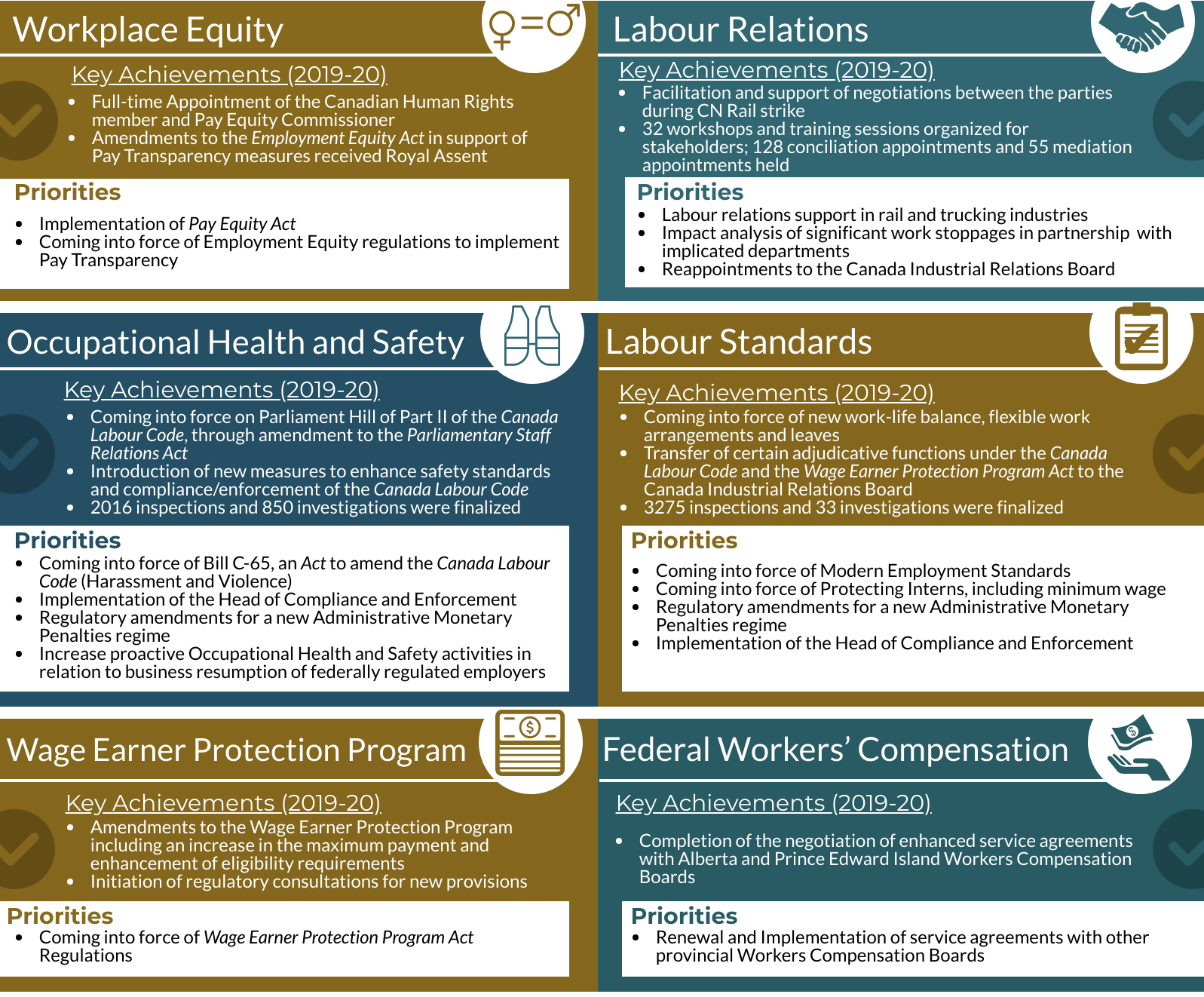
Text description of Figure 2
Workplace Equity
2019 to 2020 Key achievements
- Full-time Appointment of the Canadian Human Rights member and Pay Equity Commissioner
- Amendments to the Employment Equity Act in support of Pay Transparency measures received Royal Assent
Priorities
- Implementation of Pay Equity Act
- Coming into force of Employment Equity regulations to implement Pay Transparency
Labour Relations
2019 to 2020 Key achievements
- Facilitation and support of negotiations between the parties during Canada rail strike
- 32 workshops and training sessions organized for stakeholders; 128 conciliation appointments and 55 mediation appointments held
Priorities
- Labour relations support in rail and trucking industries
- Impact analysis of significant work stoppages in partnership with implicated departments
- Reappointments to the Canada Industrial Relations Board
Occupational Health and Safety
2019 to 2020 Key achievements
- Coming into force on Parliament Hill of Part II of the Canada Labour Code, through amendment to the Parliamentary Staff Relations Act
- Introduction of new measures to enhance safety standards and compliance/enforcement of the Canada Labour Code
- 2016 inspections and 850 investigations were finalized
Priorities
- Coming into force of Bill C-65, an Act to amend the Canada Labour Code (Harassment and Violence)
- Implementation of the Head of Compliance and Enforcement
- Regulatory amendments for a new Administrative Monetary Penalties regime
- Increase proactive Occupational Health and Safety activities in relation to business resumption of federally regulated employers
Labour Standards
2019 to 2020 Key achievements
- Coming into force of new work-life balance, flexible work arrangements and leaves
- Transfer of certain adjudicative functions under the Canada Labour Code and the Wage Earner Protection Program Act to the Canada Industrial Relations Board
- 3275 inspections and 33 investigations were finalized
Priorities
- Coming into force of Modern Employment Standards
- Coming into force of Protecting Interns, including minimum wage
- Regulatory amendments for a new Administrative Monetary Penalties regime
- Implementation of the Head of Compliance and Enforcement
Wage Earner Protection Program
2019 to 2020 Key achievements
- Amendments to the Wage Earner Protection Program including an increase in the maximum payment and enhancement of eligibility requirements
- Regulatory consultations initiated for new provisions
Priorities
- Coming into force of Wage Earner Protection Program Act Regulations
Federal Workers' Compensation
2019 to 2020 Key achievements
- Completion of the negotiation of enhanced service agreements with Alberta and Prince Edward Island Workers Compensation Board
Priorities
- Renewal and Implementation of service agreements with other provincial Workers Compensation Boards

Text description of Figure 3
International Labour Affairs
2019 to 2020 Key achievements
- Negotiation of the Canada-United States-Mexico Agreement (CUSMA) labour provisions
- Development of strong Canadian positions and chaired standard-setting discussions leading up to the adoption by the International Labour Organization (ILO) of Convention 190 and Recommendation 206 on Violence and Harassment
Priorities
- Support to the implementation of the CUSMA
- Provinces/territories involvement in the ratification of the ILO Convention 190 on Violence and Harassment
Key achievements and priorities – Management
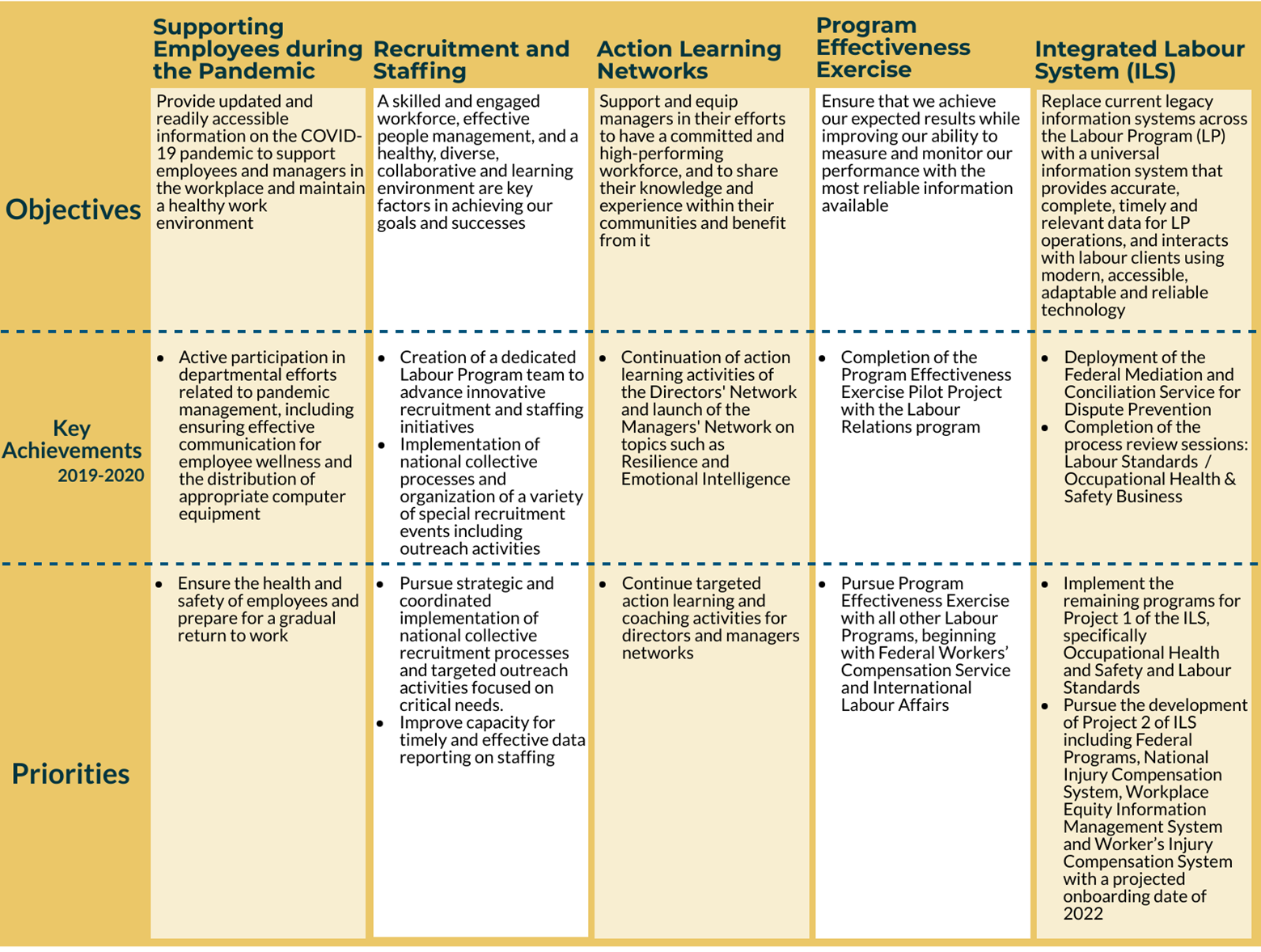
Text description of Figure 4
Objective: Supporting employees during the pandemic
Provide updated and readily accessible information in the COVID-19 pandemic to support employees and managers in the workplace and maintain a healthy work environment.
2019 to 2020 Key achievements
- Active participation in departmental efforts related to pandemic management, including ensuring effective communication for employee wellness and the distribution of appropriate computer equipment
Priorities
- Ensure the health and safety of employees and prepare for a gradual return to work
Objective: Recruitment and staffing
A skilled and engaged workforce, effective people management, and a healthy, diverse, collaborative and learning environment are key factors in achieving our goals and successes.
2019 to 2020 Key achievements
- Creation of a dedicated Labour Program team to advance innovative recruitment and staffing initiatives
- Implementation of national collective processes and organization of a variety of special recruitment events including outreach activities
Priorities
- Pursue strategic and coordinated implementation of national collective recruitment processes and targeted outreach activities focused on critical needs
- Improve capacity for timely and effective data reporting on staffing
Objective: Action learning
Support and equip managers in their efforts to have a committed and high-performing workforce, and to share their knowledge and experience within their communities and benefit from it.
2019 to 2020 Key achievements
- Continuation of action learning activities of the Directors' Network and launch of the Managers' Network on topics such as Resilience and Emotional Intelligence
Priorities
- Continue targeted action learning and coaching activities for directors and managers' networks
Objective: Program effectiveness exercise
Ensure the achievement of expected results while improving our ability to measure and monitor our performance with reliable and available information.
2019 to 2020 Key achievements
- Completion of the Program Effectiveness Exercise Pilot Project with the Labour Relations program
Priorities
- Pursue Program Effectiveness Exercise with all other Labour Programs, beginning with Federal Workers’ Compensation Service and International Labour Affairs
Objective: Integrated Labour System (ILS)
Replace current legacy information systems across the Labour Program (LP) with a universal information system that provides accurate, complete, timely and relevant data for LP operations, and interacts with labour clients using modern, accessible, adaptable and reliable technology.
2019 to 2020 Key achievements
- Deployment of the Federal Mediation and Conciliation Service for Dispute Prevention
- Completion of the process review sessions: Labour Standards / Occupational Health and Safety Business
Priorities
- Implement the remaining programs for Project 1 of the ILS, specifically Occupational Health and Safety and Labour Standards
- Pursue the development of Project 2 of ILS including Federal Programs, National Injury Compensation System, Workplace Equity Information Management System and Worker’s Injury Compensation System with a projected onboarding date of 2022
Organizational structure
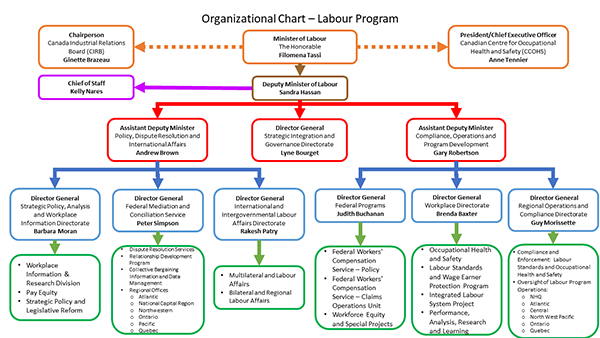
Text description of Figure 5
Organizational chart of the Labour Program
The chart starts with the Minister of Labour, The Honourable Filomena Tassi. The Chairperson of the Canada Industrial Relations Board (CIRB) Ginette Brazeau and the President/Chief Executive Officer of the Canadian Centre of Occupational Health and Safety (CCOHS) Anne Tennier report directly to her.
The Deputy Minister of Labour is Sandra Hassan. Her Chief of Staff is Kelly Nares. Assistant Deputy Minister Andrew Brown and Assistant Deputy Minister Gary Robertson, and Director General Lyne Bourget report to the Deputy Minister.
Andrew Brown is the Assistant Deputy Minister of Policy, Dispute Resolution and International Affairs (PDRIA). His organization includes the following directorates:
- The Strategic Policy, Analysis and Workplace Information Directorate (SPAWID) led by Director General Barbara Moran, under which are the following teams:
- the Workplace Information and Research Division
- Pay Equity and
- Strategic Policy and Legislative Reform
- The Federal Mediation and Conciliation Service (FMCS) led by Director General Peter Simpson, under which are the following teams:
- the Dispute Resolution Services
- Collective Bargaining Information and Data Management
- the Relationship Development Program and the
- the Regional Offices for the Atlantic, Northwestern, Ontario, Pacific, Quebec and National Capital Regions
- The International Labour Affairs Directorate lead by Director General Rakesh Patry, under which are the following teams:
- the Multilateral and Labour Affairs, and
- the Bilateral and Regional Labour Affairs
Gary Robertson is the Assistant Deputy Minister of Compliance, Operations and Program Development (COPD). His organisation includes the following directorates:
- The Federal Programs (FP), led by Judith Buchanan, under which are the following teams:
- the Federal Workers' Compensation Service - Policy
- the Federal Workers Compensation Service - Claims Operations Unit and
- Workforce Equity and Special Projects
- The Workplace Directorate (WD), led by Brenda Baxter, under which are the following teams:
- Occupational Health and Safety
- Labour Standards and Wage Earner Protection Program
- the Integrated Labour System Project, and
- Performance, Analysis, Research and Learning
- The Regional Operations and Compliance Directorate (ROCD), lead by Guy Morissette, under which are the following teams:
- Compliance and Enforcement: Labour Standards and Occupational Health and Safety
- Oversight of Labour Program:
- NHQ
- Atlantic
- Central
- North West Pacific
- Ontario
- Quebec
Lyne Bourget is the Director General Strategic Integration and Governance Directorate.
Roles and responsibilities - Labour Program
Compliance, Operations and Program Development (COPD) Branch
Assistant Deputy Minister: Gary Robertson
- Provides advice and guidance for operational policy development, implementation and compliance for workplace health and safety, labour standards, employment equity, federal workers compensation and wage earner protection programming
- Ensures that the regions apply operational programs consistently
- Updates services to improve accountability, results and performance along Labour Program business lines
- Once legislative changes are in force, the Assistant Deputy Minister (ADM) will assume the role of the Head of Compliance and Enforcement (HOCE) for the Labour Program. The ADM will exercise the powers, duties and functions related to the day-to- day administration and enforcement of Parts II, III and IV (Administrative Monetary Penalties – not yet in force) of the Code
Directorates
Federal Programs Directorate (FP)
Director General: Judith Buchanan
Develops program and operational policy, regulations and program guidance, implementation and service delivery for:
- Federal Workers Compensation
- Government Employees Compensation Act (for federal public sector employees and locally engaged staff internationally)
- Merchant Seaman Compensation Act
- Correctional Service Regulations
- Public Service Income Benefit Plan
- Workplace Equity (Employment Equity Act)
- Legislated Employment Equity Program
- Federal Contractors Program
- Workplace Opportunities: Removing Barriers to Equity
- Pay Transparency Measures (in development)
Workplace Directorate (WD)
Director General: Brenda Baxter
- Develops operational policy, regulations and implementation plans (for example, national guidelines, training) for:
- Occupational Health and Safety (OHS) (Canada Labour Code - Part II)
- Labour Standards (LS) (Canada Labour Code- Part III)
- Pending -Administrative Monetary Penalties (Canada Labour Code – Part IV (Not yet in force))
- Wage Earner Protection Program (WEPP)
- Non-smokers’ Health Act
- Undertakes branch-wide activities related to:
- maintaining stakeholder relations in OHS and LS Advisory committees
- technical/operational training for service delivery employees
- program guidance to field operations on Labour Standards and Occupational Health and Safety
- analyzing data and information
- evaluating the effectiveness of the programs administered by the Branch
- Integrated Labour System (ILS)
- administrative review function for Part IV
Regional Operations and Compliance Directorate (ROC)
Director General: Guy Morissette
ROC’s National Coordination Team supports 15 offices in five regions (Atlantic, Ontario, Quebec, Central, and North West Pacific). The directorate implements compliance strategies and quality services to clients for:
- Occupational Health and Safety (Part II of the Canada Labour Code)
- Labour Standards (Part III of the Canada Labour Code)
Policy, Dispute Resolution and International Affairs (PDRIA) Branch
Assistant Deputy Minister: Andrew Brown
- Manages relationships between international and federal/provincial/territorial partners, unions and employers
- Connects with stakeholders and partners on broad labour policy issues
- Evaluates how changing social, economic and international conditions will impact labour legislation, policies and activities
Directorates
Federal Mediation and Conciliation Service (FMCS)
Director General: Peter Simpson
- Provides mediation and conciliation services to support collective bargaining
- Delivers dispute prevention training, facilitation and grievance mediation services
- Prepares and provides advice to the Minister during mediation/conciliation and/or collective bargaining of agreements
- Collects, analyses and disseminates collective bargaining information
International and Intergovernmental Labour Affairs (IILA)
Director General: Rakesh Patry
Domestic:
- manages the secretariat for Deputy Minister-level Canadian Association of Administrators of Labour Legislation (CAALL) which supports annual meetings of FPT Ministers of Labour
- maintains federal law-making authority on labour issues in Aboriginal Self-Government Agreements
- implements strategies to work with Provincial/Territorial governments to ratify international labour conventions
International:
- leads Canada’s participation and representation in important international labour forums
- negotiates international labour conventions with other governments, employer and worker organizations at the International Labour Organization (ILO)
- negotiates international labour standards as an important component of Canada’s Free Trade Agreements and the government’s inclusive trade strategy
- provides strategic investments for capacity development with trade partner countries, and develops cooperation frameworks and memoranda of understanding with emerging economic powers
- conducts research and analysis on other countries’ labour laws and standards
Strategic Policy, Analysis and Workplace Information Directorate (SPAWID)
Director General: Barbara Moran
- Develops policy and provides legislative advice on labour relations, occupational health and safety, labour standards, employment equity, pay equity and federal workers compensation
- Undertakes research and analysis to help shape policy context of Labour Program and broader research/policy environment in field of labour
- Provides research to support policy and service improvements
- Provides advice and guidance to the LP on Budget proposals, Cabinet and legislative agendas, medium-term planning, and transition advice
Strategic Integration and Governance (SIG) Directorate
Director General: Lyne Bourget
- Provides corporate management advice and support to the Labour Program and ensures strategic alignment and integration across the Labour Program and with the department
- Undertakes special projects mandated by the DM and Labour Program Management
- Leads Labour Program-wide activities such as:
- planning, reporting and performance measurement
- information management including intranet presence and Access to Information and Privacy
- employee engagement
- governance committee support
- learning (non-operational)
- emergency and business continuity management
- accommodations
Governance structure
Deputy level governance
As a member of the Deputy community, you will be invited to Deputy Ministers’ Breakfast meetings (now called DM Coordination meetings in the COVID-19 context). All DMs and Associate DMs are members, and the Clerk uses this weekly/bi-weekly forum to debrief on Government/Cabinet priorities, promote government-wide initiatives and profile major files. Many DMs also use these meetings to informally advance bilateral business.
You will also be asked to participate in a variety of government-wide committees primarily led by PCO or TBS as well as asked to serve as Champion for a specific community or issue.
Committee membership and Champion roles are partly dictated by current mandate, background and future development needs and is managed by PCO Senior Personnel, the Coordinating Committee of Deputy Ministers (senior DM table) and the Clerk.
ESDC tiered governance structure
As the new Deputy Minister (DM) of Labour, you will be a key member of ESDC’s senior management team and tiered governance structure. You will be one of four individuals commonly referred to within the department as ‘the Deputies’: the Deputy Minister of ESDC (Graham Flack); yourself as the Deputy Minister of Labour; the Senior Associate Deputy Minister of ESDC (Kristina Namiesniowski) and the Chief Operating Officer (COO) for Service Canada (Lori MacDonald); and the Associate Deputy Minister of ESDC (Annette Gibbons).
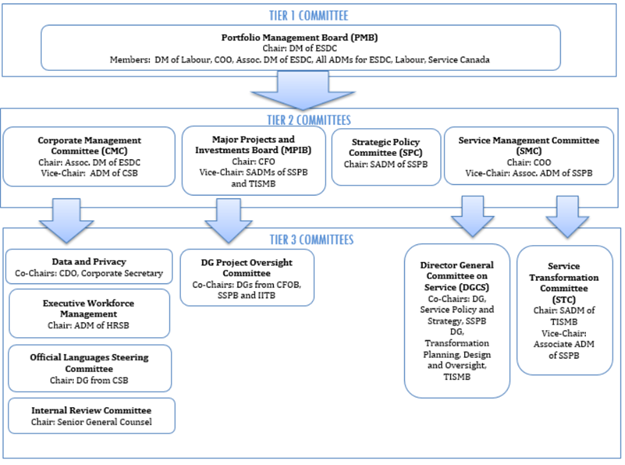
Text description of Figure 6
Employment and Social Development Canada’s governance structure chart
Tier 1 committee – first rectangle at the top of the organization chart with a box;
Portfolio Management Board (PMB)
Chair: Deputy Minister (DM) of Employment and Social Development Canada (ESDC)
Members: Deputy Miniter of Labour, Chief Operating Officer, Associate Deputy Minister of Employment and Social Development Canada (ESDC), all Assistant Deputy Ministers (ADMs) of Employment and Social Development Canada (ESDC), Labour and Service Canada.
Blue arrow pointing down to show Tier 2 committees, which report to the Portfolio Management Board (PMB).
Rectangle Tier 2 committees, Deputy Minister Direct Reports (DMDR). Consists of 4 committees:
- Corporate Management Committee (CMC)
Chair: Associate Deputy Minister of Employment and Social Development Canada (ESDC)
Assistant Deputy Minister of Citizen Services Branch (CSB)
- Major Projects and Investments Committee (MPIB)
Chair: Chief Financial Officer (CFO)
Vice-Chair: Senior Assistant Deputy Ministers (SADMs) of Strategic and Service Policy Branch (SSPB) and Transformation and Integrated Service Management Branch (TISMB)
- Strategic Policy Committee (SPC)
Chair: Senior Assistant Deputy Minister (SADM) of Strategic and Service Policy Branch (SSPB)
- Service Management Committee (SMC)
Chair: Chief Operating Officer (COO)
Vice-Chair: Associate Deputy Minister (ADM) of Strategic and Service Policy Branch (SSPB)
Blue arrows pointing down to show Tier 3 committees reporting to Tier 2 committees.
The four squares to the left of the Tier 3 committee rectangle refer to the Tier 2 committee: Corporate Management Committee (CMC)
- Data and Privacy
Co-Chair: Chief Data Office (CDO) and Corporate Secretary
- Executive Workforce Management Committee
Chair: Assistant Deputy Minister (ADM) of Human Resources Services Branch (HRSB)
- Official Languages Steering Committee
Chair: Director General from Citizen Service Branch (CSB)
- Internal Review Committee
Chair: Senior General Counsel
The second square from the left of the Tier 3 committee rectangle reports to the Tier 2 committee: Major Projects and Investments Committee (MPIB)
- Director Generals Project Oversight Committee
Co-Chair: Director Generals from Chief Financial Officer Branch (CFOB), Strategic and Service Policy Branch (SSPB) and Innovation, Information and Technology Branch (IITB)
There is no Tier 3 committee reporting to the Tier 2 committee: Strategic Policy Committee (SPC)
The last two squares of the Tier 3 committee rectangle report to the Tier 2 committee: Service Management Committee (SMG)
- Director General Committee on Service (DGCS)
Co-Chairs: Director General, Strategic and Service Policy Branch (SSPB) Director General, Transformation, Planning, Design and Oversight, TISMB
- Service Transformation Committee (STC)
Chair: Senior Assistant Deputy Minister (SADM) of Transformation and Integrated Service Management Branch (TISMB)
Vice-Chair: Associate Assistant Deputy Minister of Strategic and Service Policy Branch (SSPB)
Your participation will be required for the following Steering Committee and key Tier 1 portfolio-wide governance committees:
Steering Committee
Executive Committee (EXCOM)
Chair: DM of ESDC
Members: DM of Labour; Senior Associate DM of ESDC and COO for Service Canada; Associate DM of ESDC; SADM, Strategic and Service Policy Branch; SADM, Transformation and Integrated Services Management Branch; and Chief Financial Officer.
Frequency: Committee meets every Monday
Mandate: Identifies and oversees the development of the Department's short- and medium-term priorities and ensures alignment of all corporate committee business. EXCOM provides a venue for Tier One and Tier Two committee chairs to report out on major decisions and issues, and for items requiring corporate committee consideration or decision to be assigned to the appropriate committee.
Tier 1
Portfolio Management Board (PMB)
Chair: DM of ESDC
Members: DM of Labour; Senior Associate DM of ESDC and COO for Service Canada; Associate DM of ESDC; SADMs; ADMs; CFO; CIO; Chief Audit Executive; Corporate Secretary; Senior General Counsel and Head of Legal Services.
Frequency: Committee meets every Thursday with two annual PMB Retreats.
Mandate: Acts as the main decision-making body of the Portfolio (ESDC, Labour Program, Service Canada) by:
- determining strategic directions and priorities
- approving portfolio-wide plans and strategies
- making decisions on strategic issues that affect the Portfolio as a whole
In addition, PMB functions as a key vehicle for information sharing, consultation and collaboration between DMs and ADMs.
Tier 2
Tier 2 Committees are principally at the ADM level and related to corporate management, major project governance, service management and strategic policy. LP representation on these committees is assigned to specific LP ADMs and DGs who debrief colleagues on relevant matters.
Tier 3
Tier 3 Committees are principally at the DG level and related to data privacy, workforce management, official languages and service transformation. LP representatives on these committees debrief colleagues on relevant matters.
Mandated Committees
Not depicted in the above diagram, but in addition to the above committees, your participation will be sought to attend the following mandated committees as an ex-officio member:
Canada Employment Insurance Commission
Chair: DM of ESDC and Co-Chair, COO
Members: The Commissioner for Workers and the Commissioner for Employers
Frequency: (TBC)
Mandate: The CEIC plays a leadership role, with Employment and Social Development Canada (ESDC), in overseeing the Employment Insurance (EI) program. For more than 75 years, this tripartite organization has included representation from business, labour and the Government of Canada.
Departmental Audit Committee (DAC)
Chair: DM of ESDC
Members: At least 3 independent, external members recruited from outside of the federal public administration and 5 ex-officio members: DM of Labour; Senior Associate DM of ESDC and COO for Service Canada; Associate DM of ESDC; Chief Financial Officer; and, Chief Audit Executive.
Frequency: Twice a year
Mandate: Acts as a strategic resource which provides objective advice and recommendations to the DM of ESDC regarding the sufficiency, quality and results of assurance on the adequacy and functioning of the Department's risk management, control and governance processes.
There are a number of additional ESDC committees at the executive, management and working levels on which the Labour Program is represented by a LP ADM or DG to ensure alignment and integration with the rest of the portfolio where appropriate.
Performance Management and Evaluation Committee (PMEC)
Chair: DM of ESDC
Members: Ex-officio members: DM of Labour, Senior Associate DM of ESDC, COO.
Other members: ESDC ADMs and some departmental DGs
Frequency: Six to eight times a year
Mandate: The Performance Measurement and Evaluation Committee (PMEC) serves as an advisory body to the Deputy Minister on matters relating to the department’s performance and evaluation activities. PMEC reviews and advises on the Departmental Results Framework, Program Inventory and related Performance Information Profiles as well as on departmental evaluation planning and activities including final evaluation reports and other evaluation-related activities of the Department.
Labour Program governance structure
The Labour Program also has its own internal governance structure to support decision-making, information sharing and horizontal collaboration. This governance model has proven effective and successful in building a strong and collaborative senior management team.
The Labour Program Management Meeting (LPMM) and Quadritlateral (QUAD) meeting are your main senior management tables. There is a separate committee chaired by the ADM of PDRIA for policy related discussions, a dedicated committee co-chaired by the ADMs for people management purposes as well as a union-management consultation committee co-chaired by a senior union representative and the LP ADMs. The Crisis Management Team is chaired by the ADM of PDRIA and works with DG SIG to manage emergency situations that impact internal operations, such as the response to the COVID-19 pandemic. In addition, both ADMs have their own respective management tables: Branch Management Meeting (PDRIA-BMC); and, Branch Executive Committee (COPD-BEC) comprising LP ADMs, DGs and Directors.
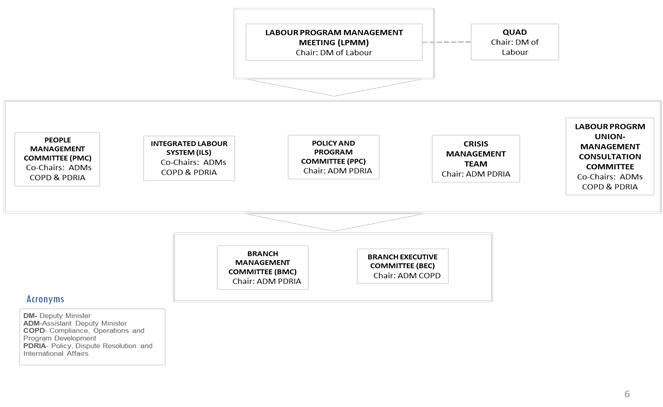
Text description of Figure 7
Labour Program governance structure table
First rectangle at the top of the organization chart with a square;
Labour Program Management Meeting (LPMM)
Chair: Deputy Minister (DM) of Labour
Still at the first line of the organization chart, in a separate square to the right of the Labour Program Management Meeting;
QUAD
Chair: Deputy Minister of Labour
Rectangle on the second line of the organization chart, which contains five squares at the same level.
- People Management Committee (PMC)
Co-Chair: Assistant Deputy Ministers (ADM) of Compliance, Operations and Program Development (COPD) and Policy, Dispute Resolution and International Affairs (PDRIA)
- Integrated Labour System (ILS)
Co-Chair: Assistant Deputy Ministers (ADM) of Compliance, Operations and Program Development (COPD) and Policy, Dispute Resolution and International Affairs (PDRIA)
- Policy and Program Committee (PPC)
Chair: Assistant Deputy Minister (ADM) of Policy, Dispute Resolution and International Affairs (PDRIA)
- Crisis Management Team
Co-Chair: Assistant Deputy Minister (ADM) of Policy, Dispute Resolution and International Affairs (PDRIA)
- Labour Program Union-Management Consultation Committee
Co-Chair: Assistant Deputy Ministers (ADM) of Compliance, Operations and Program Development (COPD) and Policy, Dispute Resolution and International Affairs (PDRIA)
Third and final organizational chart rectangle with two squares
- Branch Management Committee (BMC)
Co-Chair: Assistant Deputy Minister (ADM) of Compliance, Operations and Program Development (COPD)
- Branch Executive Committee (BEC)
Co-Chair: Assistant Deputy Minister (ADM) of Policy, Dispute Resolution and International Affairs (PDRIA)
Acronym legend:
- DM:
- Deputy Minister
- ADM:
- Assistant Deputy Minister
- COPD:
- Compliance, Operations and Program Development
- PDRIA:
- Policy, Dispute Resolution and International Affairs
- LP:
- Labour Program
Quadrilateral Meeting (QUAD)
Chair: DM of Labour
Members: ADM-COPD; ADM-PDRIA; DG-SIG; and Chief of Staff to DM of Labour
Frequency: Committee meets bi-weekly
Mandate: Provides a forum for the DM’s direct reports to bring various LP key files and initiatives, principally of a corporate management or administrative nature, for direction and pulse check, often prior to being brought to other LP governance committees for information, discussion or decision.
Labour Program Management Meeting (LPMM)
Chair: DM of Labour
Members: ADM-COPD; ADM-PDRIA; all seven LP DGs; Chief of Staff to DM of Labour; Senior Advisor to the LP DM; senior representatives from the Chief Financial Officer Branch, the Public Affairs and Stakeholder Relations Branch and Legal Services.
Frequency: Committee meets every Monday
Mandate: Acts as the main governance forum for the Labour Program by providing a setting for:
- information sharing, consultation and collaboration
- debate and advice on corporate and administrative management issues
- medium- and longer-term planning and innovation, key projects, important proposals, and review of key milestones
- coherence and effectiveness of the Labour Program within Employment and Social Development Canada
LPMM also serves as the Labour Program’s Crisis Management Committee.
Labour Program People Management Committee (LP PMC)
Co-Chairs: Alternating ADMs of Labour
Members: LP DGs, Chief of Staff to LP DM; and, representatives of the staffing and classification divisions of the Human Resources Services Branch
Frequency: Committee meets meet twice monthly (or as required). If required an Adhoc meeting can be requested.
Mandate: The Labour Program People Management Committee provides strategic leadership and oversight of recruitment and staffing activities, performance management, talent management and other human resources management activities for the Labour Program.
Integrated Labour System (ILS) Steering Committee
Chair: Co-Chaired by the ADMs of Labour
Membership: All LP DGs; Chief of Staff to the LP DM; Chief Information Officer of IITB; Director General of Chief Solution Office IITB; LP Executive Director of ILS Project Executive; and Executive Director of IITB ILS Project Lead
Frequency: Committee meets once a month
Mandate: The ILS is working to replace legacy information technology systems across the LP with an integrated system that provides accurate, complete, timely and relevant data for LP operations. The new systems will streamline client interactions with the LP through a modern case management system and online service tools.
Labour Program Policy and Program Committee (PPC)
Chair: ADM, PDRIA
Members: ADM, COPD; all LP DGs; Senior Counsel and Group Head of Labour and Service Delivery; and LP Senior Director, Strategic Policy and Legislative Reform
Frequency: Committee meets monthly (on the fourth Friday of the month), except during the months of July and August.
Mandate: The PPC is a forum for the discussion of all major policy and program initiatives. Key responsibilities include:
- providing a structured mechanism for input and feedback on policy and program files
- contributing to policy and program excellence through a vigorous and collegial challenge function
- ensuring effective forward program and policy planning in the Labour Program, including identifying and reporting on emerging risks and priority issues
- ensuring that the Labour Program’s policy and program policy agenda is considered and implemented in a horizontal, strategic and integrated manner
Note that the PPC does not function as a gatekeeper for the approval of policy and program files. Policy briefings and advice to you occur through regular bilateral meetings with your ADMs and separate file specific meetings.
Labour Program Union-Management Consultation Committee (LPUMCC)
Co-Chairs: Alternating ADMs of Labour and Kevin King, National President of the Union of National Employees (UNE). In practice, Andrew Shaver, National Executive Vice-President of the UNE co-chairs on behalf of the UNE National President.
Members: Comprises three unions: the UNE, which is a national component of the Public Service Alliance Canada (PSAC); the Professional Institute of the Public Service of Canada (PIPSC); and the Canadian Association of Professional Employees (CAPE); all LP DGs; Director General, Operations, Human Resource Services Branch; and, Director, Corporate Labour Relations, Human Resources Services Branch.
Frequency: Committee meets three times a year.
Mandate: The LPUMCC forum provides an opportunity for meaningful consultation on human resources and operational policies and direction, and other relevant issues.
There is also a departmental Human Resources Union-Management Consultation Committee (HRUMCC) co-chaired by the ADM, Human Resources Services Branch ESDC and a union representative. Due to COVID-19 this Committee is temporarily combined with the Service Union Management Consultation Committee (SUMCC).
B. ESDC Senior management and ADMs of enabling services
Labour Program Assistant Deputy Minister - Policy, Dispute Resolution and International Affairs (PDRIA) - Andrew Brown
Andrew Brown

Andrew became Assistant Deputy Minister of Policy, Dispute Resolution and International Affairs in March 2021.
He started his public service career when he joined Citizenship and Immigration Canada through the foreign service recruitment program. He worked overseas in countries such as Turkey and the United Kingdom before returning to the national capital region where he worked on immigration, refugee and citizenship policies and programs. He worked for two years as an Advisor at the Privy Council Office on files related to the Canada-United States border. He then joined Employment and Social Development Canada (ESDC) in August 2014, where he eventually became Director General of the Employment Insurance Policy Directorate from May 2017 to February 2021.
Andrew holds a Bachelor of Sciences (with Honours) degree from Queen’s University (Kingston) and a doctorate in Physics from the University of Alberta.
The following Director Generals (DG), presented with their title and picture, report to ADM PDRIA:
Peter Simpson is the Director General (DG) for Federal Mediation and Conciliation Service (FMCS)

Barbara Moran is the DG for Strategic Policy, Analysis and Workplace Information Directorate (SPAWID)

Rakesh Patry is the DG for International and Intergovernmental Labour Affairs (IILA)

Labour Program Assistant Deputy Minister - Compliance, Operations and Program Development (COPD) - Gary Robertson
Gary Robertson

Mr. Robertson was appointed as the Assistant Deputy Minister, Compliance, Operations and Program Development, at the Labour Program effective September 21, 2015. He was appointed by Governor in Council as Chair of the Canadian Centre for Occupational Health and Safety on December 21, 2016.
Prior to joining the department Mr. Robertson held:
- Senior roles at Public Safety Canada including:
- Assistant Deputy Minister of the National Cyber Security Branch
- Chief Financial Officer and Assistant Deputy Minister, Corporate Management Branch
- Various executive roles at Public Works and Government Services Canada, Treasury Board Secretariat and Indian and Northern Affairs Canada
- Various roles in the private sector with large international organizations including Nortel Networks and PricewaterhouseCoopers
Mr. Robertson holds a Bachelor of Arts from the University of Western Ontario and a Master of Business Administration from the University of Hartford. He is a CPA, CMA and also holds a number of board certifications (such as, C.Dir., A.C.C., H.R.C.C.C.).
The following Director Generals (DG), presented with their title and picture, report to ADM COPD:
Judith Buchanan is the DG for Federal Programs Directorate (FP)

Brenda Baxter is the DG for Workplace Directorate (WD)

Guy Morissette is the DG for Regional Operations and Compliance Directorate (ROC)
Labour Program Director General - Strategic Integration and Governance (SIG) - Lyne Bourget
Lyne Bourget

Ms. Bourget was appointed as Director General, Strategic Integration and Governance in August 2015.
Ms. Bourget has over thirty years of experience in the public sector.
Before joining Employment and Social Development Canada, she worked in various federal organizations including:
- The Privy Council Office
- The Department of Finance
- The Department of Communications
- The Canada Information Office/Communication Canada
- The House of Commons Administration
- The Department of Canadian Heritage
- The Social Security Tribunal
She has acquired extensive experience in corporate management as well as in federal/provincial/territorial relations.
Ms. Bourget holds a Bachelor’s degree in Administration from the University of Ottawa.
Minister of Labour - The Honourable Filomena Tassi,
The Honourable Filomena Tassi, MP (Hamilton West—Ancaster—Dundas)

The full bio of Minister Tassi can be found on her official profile page.
Deputy Minister of ESDC - Graham Flack
Graham Flack

The full bio of Deputy Minister Flack can be found on his official profile page.
Senior Associate Deputy Minister and Chief Operating Officer of Service Canada - Lori MacDonald
Lori MacDonald

The full bio of Senior Associate Deputy Minister and Chief Operating Officer of Service Canada MacDonald can be found on her official profile page.
Assistant Deputy Minister of Human Resources Services - Darlènee de Gravina
Darlène de Gravina

Darlène de Gravina is the Assistant Deputy Minister (ADM) of the Human Resources Services Branch (HRSB), Employment and Social Development Canada (ESDC). Darlène has held several key positions within the public service, including the Canadian Food Inspection Agency as Vice-President of the Human Resources Branch.
Darlène previously served as:
- Head of Human Resources at the Department of Canadian Heritage
- The former Canadian International Development Agency
- Defence Research and Development Canada
She held prior positions in and out of Human Resources at:
- The Department of National Defence
- The Public Service Commission of Canada
- The Correctional Service of Canada
She holds a degree in Commerce from Queen’s University, and a Certificate in Public Sector Leadership and Governance from the University of Ottawa.
A native Montrealer, Darlène enjoys travel and cycling.
Acting Assistant Deputy Minister of Public Affairs and Stakeholder Relations - Debora Brown
Debora Brown

Since January 2020, Debora Brown has been acting in the role of Assistant Deputy Minister of the Public Affairs and Stakeholder Relations Branch. Prior to that, Debora served as the Director General of Employment Communications and Operations since joining the department in May 2014, where she oversaw strategic communications for skills, employment, learning and labour files. She also managed several centres of expertise, including speechwriting, social media, events, media relations and ministerial liaison.
Debora has also served at the Director General level leading teams of communications specialists in a number of other portfolios, including Finance Canada (2012 to 2014),Foreign Affairs and International Trade Canada (2009 to 2012), and the Privy Council Office (2006 to 2009).
Debora graduated from the University of Ottawa with a Bachelor’s of Arts Degree with Honours in Communications and a Concentration in Psychology. Following her graduation, she began her career at the former Employment and Immigration Canada in 1991, where she learned the ropes in government communications.
From 1996 to 2000, Debora obtained the position of Director of Communications to the Minister of Foreign Affairs, before joining the Privy Council Office as a Senior Analyst in the Communications and Consultation Secretariat between 2001 and 2006.
Chief Financial Officer - Mark Perlman
Mark Perlman

Mr. Perlman joined Employment and Social Development Canada (ESDC) on September 10, 2016 as the Chief Financial Officer. In this role, he is responsible for all aspects of financial management and stewardship. He is a key player in supporting the Deputy Ministers for the ESDC portfolio.
Prior to coming to ESDC, Mr. Perlman was the following:
- the Chief Financial Officer and ADM Corporate Management Branch for the Department of Public Safety
- the Deputy Assistant Commissioner and Agency Comptroller, Finance and Administration Branch at the Canada Revenue Agency
Mr. Perlman brings with him a wealth of experience, having worked in several federal departments.
Mark has a bachelor's degree from McMaster University and is a Chartered Professional Accountant (CPA, CMA).
Assistant Deputy Minister and Chief Information Officer - Peter Littlefield
Peter Littlefield

Peter Littlefield is Assistant Deputy Minister and Chief Information Officer of Employment and Social Development Canada (ESDC), the Government of Canada’s primary social benefits ministry. He has held this role since September 2016.
Prior to joining ESDC:
- Peter was the lead for the consolidation of the Government of Canada’s data centres at Shared Services Canada, since its creation in 2011
- Peter also contributed to government-shared services as product management executive for distributed computing services and data centre services at Public Works and Government Services Canada
Before joining the federal public service in 2007, Peter held a number of key positions in the private sector for over 20 years in the information technology (IT) sector. Peter also contributed in areas of infrastructure planning and design. As well as solutions architecture before moving on to management.
Peter co-founded two Canadian IT companies specializing in communications software and in management consulting.
Peter holds a Bachelor of Mathematics degree from the University of Waterloo.
He is well-supported and well-grounded by his wife and three daughters.
Chief Audit Executive - Sheri Ostridge
Sheri Ostridge

Sheri Ostridge is the Chief Audit Executive and Chief Risk Officer at ESDC.
Sheri has 20 years of experience with the Government of Canada, having worked previously at:
- Veterans Affairs
- Fisheries and Oceans
- The Atlantic Canada Opportunities Agency
Sheri worked in the academic and private sector before joining the Government of Canada.
Sheri has obtained the following:
- Certified Internal Auditor (CIA)
- 2002, Master degree in Education from the University of Prince Edward Island
- 1994, Bachelor degree in Public Relations from Mount Saint Vincent University
Corporate Secretary and Chief Privacy Officer - Jessica Kerr
Jessica Kerr

Jessica Kerr was appointed as the Corporate Secretary and Chief Privacy Officer at Employment and Social Development Canada (ESDC) on November 13, 2018.
In her current role, Ms. Kerr provides:
- Strategic management for Privacy and Access to Information
- Parliamentary Affairs
- Business Management and Executive Committees
- Ministerial and Executive Briefings
- Ministerial Correspondence
- The Governor in Council appointment framework and selection process across the Portfolio of Employment and Social Development Canada
Ms. Kerr has over twenty (25) years of diverse experience in various government departments including:
- the Department of Justice
- Solicitor General
- Revenue Canada and Citizenship
- Immigration Canada
- Since 2010, with ESDC
Ms. Kerr was able to gain extensive experience such as:
- the development and management of programs
- complex social policy issues
- building and sustaining partnerships with internal and external stakeholders
Ms. Kerr holds a Bachelors of Arts degree in Sociology from Concordia University, and a Master’s Degree in Criminology from University of Ottawa.
Senior General Counsel and Head of Legal Services - Mark L. McCombs
Mark L. McCombs

Mr. Mark L. McCombs is a Department of Justice lawyer, Senior General Counsel and Head of the Legal Services Unit for the Department of Employment and Social Development (ESDC).
Mr. McCombs joined the Department of Justice in 1988. He has been a member of the following services:
- Legal Services Units providing advice to the Royal Canadian Mounted Police
- the Department of Fisheries and Oceans
- the Department of Western Economic Diversification
- 1997 to 2005, Head of Legal Services for the Canadian Food Inspection Agency
- May 2005, Head of the Legal Services for Human Resources and Skills Development Canada and for Social Development Canada (now known as ESDC)
Mr. McCombs educational degrees:
- 1978, Bachelor of Arts from the University of Western Ontario
- 1981, LL.B. from the University of Ottawa
Mr. McCombs was called to the Ontario Bar in 1983.
C. ESDC overview
Alternate formats
Employment and Social Development Canada – ESDC 101
ESDC builds a strong Canadian economy where all Canadians have opportunities to participate and benefit.
The ESDC 101 infographic gives an overview of the core programs and services offered to Canadians throughout their lives; it shows the scale of the Department’s importance and the extent to which its budget directly benefits Canadians in all parts of the country. Through its programs and services, ESDC ensures that post-secondary education and apprenticeship training are more affordable and accessible to all Canadians, and that eligible Canadians are provided with retirement, survivor and disability benefits. The Department offers programs and initiatives that promote skills development and labour market participation, provides temporary income support to eligible unemployed workers, and conducts research and analysis on labour and workplace issues.
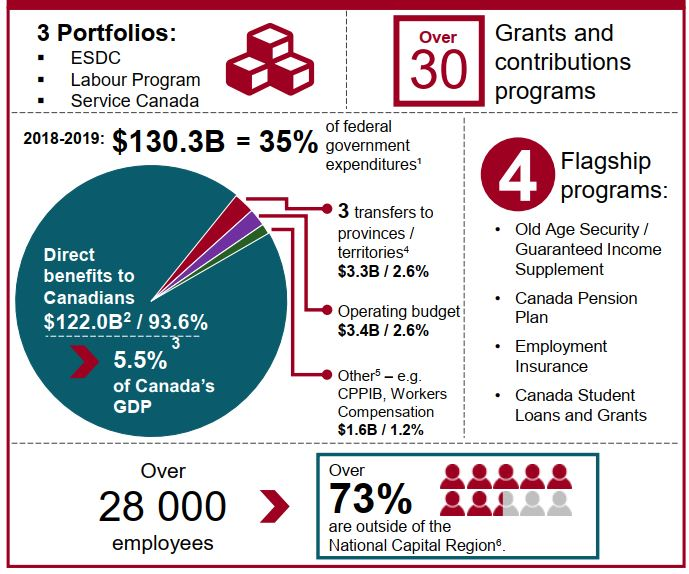
Text description of Figure 8
Who we are
- The Department has three portfolios: Employment and Social Development Canada, the Labour Program and Service Canada.
- ESDC administers over 30 grants and contributions programs.
- In 2018 to 2019, ESDC spent $130.3 billion on its wide array of policy, programs and services, representing 35% of total federal government expenditures 1. Of that amount, 93.6% ($122 billion) were to provide direct benefits to Canadians 2, corresponding to 5.5% 3 of Canada’s gross domestic product. A further 2.6% ($3.3 billion) was transferred to the provinces and territories 4.
- The Department's gross operating budget represented 2.6% ($3.4 billion) of the overall department’s spending. In addition, another 1.2% ($1.6 billion) was provided to other government departments and organizations 5.
- Four flagship programs: Old Age Security/Guaranteed Income Supplement, Canada Pension Plan, Employment Insurance and Canada Student Loans.
- As of June 30, 2020 Employment and Social Development Canada has over 28 000 employees, over 73% of whom are located outside of the National Capital Region 6.
- Notes in image "Who we are"
- 1 If the Canada Pension Plan expenditures, which are not consolidated in the federal public accounts, are excluded, ESDC's expenditure represent 25% of total federal government expenditures in 2018 to 2019.
- 2 $122B is comprised of statutory payments made directly to Canadians as well as programs providing benefits to Canadians through grants and contributions.
- 3 www150.statcan.gc.ca/t1/tbl1/en/tv.action?pid=3610010401
- 4 The transfers to provinces and territories include Labour Market Development Agreements (Employment Insurance-funded), Workforce Development Agreements and Early Learning and Child Care.
- 5 This includes administrative costs related to Canada Pension Plan Investment Board, administrative costs of other federal department related to delivery of Employment Insurance benefits, Employment Insurance doubtful accounts and Workers Compensation.
- 6 This excludes casuals, students, terms under 3 months, part-time workers, and leave without pay.
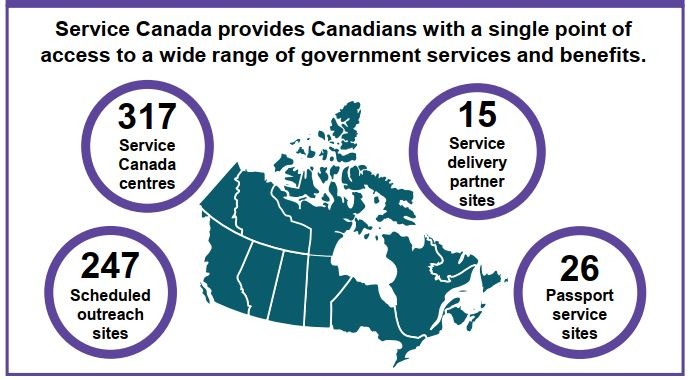
Text description of Figure 9
Where you can find us
- Service Canada provides Canadians with a single point of access to a wide range of government services and benefits.
- Canadians are able to access our services across the country at 317 Service Canada Centres, 247 scheduled outreach sites, 15 service delivery partner’s sites, and 26 passport service sites.[STT[14]
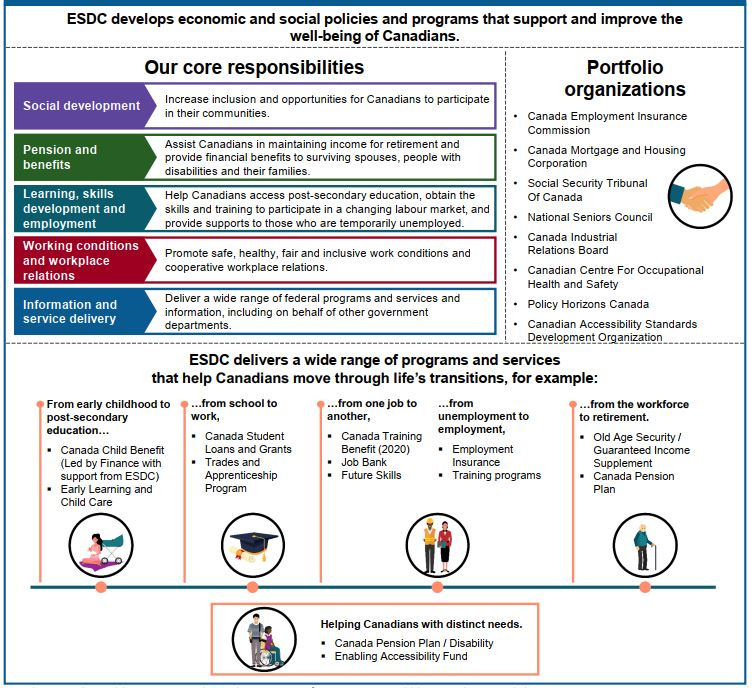
Text description of Figure 10
What we do
Employment and Social Development Canada develops economic and social policies and programs that support and improve the well-being of Canadians.
Our Core Responsibilities
- Social development - increase inclusion and opportunities for Canadians to participate in their communities
- Pension and benefits - assist Canadians in maintaining income for retirement, and provide financial benefits to survivors, people with disabilities and their families
- Learning, skills development and employment - help Canadians access post-secondary education and get the skills and training they need to participate in a changing labour market and provide support to those who are temporarily unemployed
- Working conditions and workplace relations - promote safe, healthy, fair and inclusive working conditions and cooperative workplace relations; and
- Information and service delivery - deliver a wide range of federal programs and services and information, including on behalf of other government departments
Portfolio organizations
- Canada Employment Insurance Commission
- Canada Mortgage and Housing Corporation
- Social Security Tribunal of Canada
- National Seniors Council
- Canada Industrial Relations Board
- Canadian Centre for Occupational Health and Safety
- Policy Horizons Canada
- Canadian Accessibility Standards Development Organization
Employment and Social Development Canada delivers a wide range of programs and services that help Canadians move through life’s transitions, for example:
From early childhood to post-secondary education…
- Canada Child Benefit (led by Finance with support from ESDC)
- Early Learning and Child Care
…from school to work,
- Canada Student Loans and Grants
- Trades and Apprenticeship Program
…from one job to another,
- Canada Training Benefit (2020)
- Job Bank
- Future Skills
…from unemployment to employment,
- Employment Insurance
- Training programs
…from the workforce to retirement.
- Old Age Security / Guaranteed Income Supplement
- Canada Pension Plan
Helping Canadians with distinct needs
- Canada Pension Plan - Disability
- Enabling Accessibility Fund
